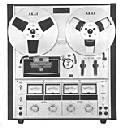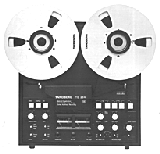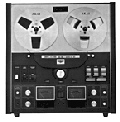|
AIFF |
The is the Apple Interchange File Format and is native to the Macintosh world. If you are making sounds files on the Mac and donít know what format they are in, this is probably the one. They can be transferred easily to the IBM world.
|
|
WAV |
This is the PC equivalent of the Mac AIFF. Developed by Microsoft and IBM, it is the standard sound file format used on Windows systems. It is also quite popular on the Internet, though compression technologies are superseding it.
|
|
AU |
One of the oldest sound type around, it was one of the first file types to be widely supported on the Internet.
|
|
RealAudio |
This format has taken the Internet by storm. A special player, free from http://www.real.com, is required. Unlike the three previously mentioned formats, it is not necessary to download an entire RealAudio sound file before you can start listening to it. RealAudio files "stream," that is, they start playing as they are downloading. The price paid for this technology is that the original sounds are usually sampled at a lower rate and the file is then compressed with an algorithm that throws away some of the sounds that it "thinks" that the listener might not care about anyway.
At best, the result can sound like listening to FM radio. At worst, it can sound like listening to an AM radio played over a telephone. Despite these shortcomings, it also allows the streaming of live content, a feature that lets thousands of radio stations feed their signals into the Internet. If you are interested in hearing these radio stations, point your web browser to www.broadcast.com.
|
|
MPEG |
Developed by the Motion Pictures Experts Group, the sound file formats that have come out of this organization are quite amazing, especially the latest MP3 variety. Once a sound has been recorded in a standard format, such as AIFF or WAV, it is compressed using a proprietary algorithm that results in a better quality, though slightly larger file than that found in the RealAudio method. The advantage here is that the original file size can be reduced by 90% with virtually no loss in quality. A selection from an audio CD, which might easily be 50 megabytes in size, can be squeezed down to 5 megabytes, making downloading almost a reasonable operation. A special player is required to listen to these files and free ones are available on the Internet in many places for both Windows and the Macintosh (www.mp3.com).
It is this technology that has the recording industry up in arms, and rightly so. Using a piece of software called a CD-ripper, the contents of an audio CD can be moved to the hard drive in a matter of minutes. The resulting files, usually in AIFF or WAV formats, can then be compressed in a batch operation that yields the individual MP3 files. These files can then be placed on a Web page for others to download, a clear copyright violation.
|
|
SoundVQ |
Similar to MP3, this competing compression method was developed by NTT Corporation and is supported by Yamaha. Like MP3, a special player is required, which can be download from the Yamaha SoundVQ website (www.yamaha.co.jp/english/xg/SoundVQ/) in either Mac or Windows formats. As of this writing I have not used this file type but have read that it is superior, in some ways, to the MP3.
|
|
MIDI |
While this is not a sound file format that is used to record sounds from the real world, it does play back sounds, but of the computer-generated musical variety. MIDI (Musical Instrument Digital Interface) is the world standard in how we connect musical instruments, such as electronic keyboards to our computers. Rather than storing digital information about the original sound, a MIDI file contains data about what notes were played, their duration, and the instrument that should play them. Compared to other sound formats, MIDI files are very small, typically less than 100,000 bytes.
|

 I use 4-track reel-to-reel machines to make the off-the-air recordings. I have used quite a few machines over the years, though my real workhorses have been an Akai 202D-SS and a Tandberg TD20A. The Tandberg has 10-inch reels and was used to pull several hours at a time off the air. I have since retired the Akai, replacing it with another Akai, this one a GX-260D. I use no noise reduction or equalization in making the recordings.
I use 4-track reel-to-reel machines to make the off-the-air recordings. I have used quite a few machines over the years, though my real workhorses have been an Akai 202D-SS and a Tandberg TD20A. The Tandberg has 10-inch reels and was used to pull several hours at a time off the air. I have since retired the Akai, replacing it with another Akai, this one a GX-260D. I use no noise reduction or equalization in making the recordings. My usual procedure was to capture the shows on the weekends, when most of them were played, and then transfer them to my archive tapes during the week. I have used a variety a tapes, for a long time favoring 3600-foot tapes on 7-inch reels. This was because of cost and availability at the time. In retrospect, this might not have been a good idea due to issues on tape life, but what's done is done.
My usual procedure was to capture the shows on the weekends, when most of them were played, and then transfer them to my archive tapes during the week. I have used a variety a tapes, for a long time favoring 3600-foot tapes on 7-inch reels. This was because of cost and availability at the time. In retrospect, this might not have been a good idea due to issues on tape life, but what's done is done. The first dozen or so reels were recorded in 4-track mono, which puts one program on the left channel and one on the right. While this certainly maximizes the cost of tape, there is a problem that can occur called crosstalk. This is where the sound on one track can be heard slightly in the other. While I can retrieve shows from the tapes that I made that way with no crosstalk, I became pretty paranoid about it and switched to recording in stereo, placing the same program in both the left and right channels.
The first dozen or so reels were recorded in 4-track mono, which puts one program on the left channel and one on the right. While this certainly maximizes the cost of tape, there is a problem that can occur called crosstalk. This is where the sound on one track can be heard slightly in the other. While I can retrieve shows from the tapes that I made that way with no crosstalk, I became pretty paranoid about it and switched to recording in stereo, placing the same program in both the left and right channels.